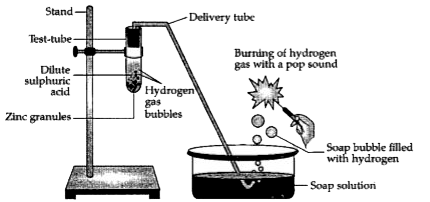
(a) Identify the gasses evolved at the anode and cathode in the above experimental set up.
(b) Name the process that occurs. Why is it called so?
(c) Illustrate the reaction of the process with the help of a chemical equation.
Step by step video & image solution for (a) Identify the gasses evolved at the anode and cathode in the above experimental set up. (b) Name the process that occurs. Why is it called so? (c) Illustrate the reaction of the process with the help of a chemical equation. by Chemistry experts to help you in doubts & scoring excellent marks in Class 10 exams.
Updated on:21/07/2023Topper's Solved these Questions
- SAMPLE PAPER 2023 TERM IBOOK - CBSE MODEL PAPERCHAPTER - SAMPLE PAPER 2023 TERM IEXERCISE - SECTION-E
1 Videos
- SAMPLE PAPER 2023 TERM IBOOK - CBSE MODEL PAPERCHAPTER - SAMPLE PAPER 2023 TERM IEXERCISE - SECTION-B
2 Videos
- SAMPLE PAPER 2022 TERM IIBOOK - CBSE MODEL PAPERCHAPTER - SAMPLE PAPER 2022 TERM IIEXERCISE - SECTION B
4 Videos
Similar Questions
Study the given experimental set-up and answer the following questions.

Write the products formed in the above process:
View Solution
Identify the above process in bacteria and identify part A,B &C:
View SolutionSketching and labeling a galvanic cell: Design a galvanic cell that uses the redox reaction
Fe(s)+2Fe3+(aq.)→3Fe2+(aq.)
Identify the anode cathode half-reactions and sketch the experimental setup. Label the anode and cathode, indicate the directon of elecron and ion flow, and identify the sign of each elctrode.
Strategy: First sepreate the overall cell reaction into anode (oxidation) and cathode (reduction) half-reactions. Then, set up two half-cells that use half-reactions, and connect the half-cells with a conducating wire and a salt bridge.
View SolutionHow would you convert:
(a) ethanol into ethene?
(b) propanol into propanoic acid? Name the process in each case and write the equations of the reaction involved
View SolutionA brown substance 'X' on heating in air forms a substance 'Y'. When hydrogen gas is passed over heated 'Y', it again changes back into 'X'.
(i) Name the substances X and Y.
(ii) Name the chemical processes occurring during both the changes.
(iii) Write the chemical equations.
View SolutionWhen electrolysis of water is done then :
(a) Identify the gases evolved at cathode and anode. (write equations also)
(b) Why is amount of gas collecte in one of the other ? Name this gas .
View Solution(a) Draw the structure of methane by showing sharing of electron between carbon and hydrogen atoms. How will you convert methane into chloroform (CHCl3) by substitution reaction? Explain with the help of chemical equations.
(b) Write the name and general formula of a chain of hydrocarbons in which an addition reaction with hydrogen can take place. stating the essential conditions reuqired for an addition reaction to occur, write the chemical equation giving the name of the reactant and the product of such a reaction.
View SolutionWrite the anode and cathode half -reactions and sketch the experimental set - up .Label the anode and the cathode , identify the sign of each electrode and indicate the direction of electron and ion flow . 2Al(s)+3Cd2+(aq)→2Al3+(aq)+3Cd(s)
View SolutionWrite steps to convert these ores into metals, giving chemical equations of the reactions that take place.
How are broken railway tracks joined ? Give the name of the process and the chemical equation of the reaction involved.
View SolutionDry pellets of base 'X' when kept in open absorb moisture and turn sticky. The compound is also formed by chlor-alkali process. Write chemical name and formula of X. Describe chlor-alkali process with balanced chemical equation. Name the type of reaction that occures when X is treated with dilute hydrochloric acid. Write the chemical equation. While diluting an acid, why is it recommended that the acid should be added to water and not water to the acid ?
View Solution
